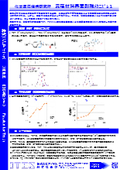Measurement of resin curing degree using FT-IR.
It is possible to monitor the progress of the adhesive curing reaction (degree of curing)!
FT-IR spectra sensitively reflect the bonding states of organic materials, making it possible to monitor the progress of adhesive curing reactions (degree of curing). The procedure for measuring the degree of curing of the resin involves comparing the spectra of unreacted materials with those of materials after 100% reaction to identify the changing regions. The degree of curing for unreacted materials is set at 0%, and that for reacted materials is set at 100%. The peak intensity of the measurement sample spectrum is interpolated to determine the reaction rate (degree of curing). 【Procedure for Measuring Degree of Curing】 ■ Compare the spectra of unreacted materials with those of materials after 100% reaction to identify the changing regions. ■ Set the degree of curing for unreacted materials at 0% and that for reacted materials at 100%. ■ Interpolate the peak intensity of the measurement sample spectrum to determine the reaction rate (degree of curing). *For more details, please refer to the PDF document or feel free to contact us.
basic information
For more details, please refer to the PDF document or feel free to contact us.
Price range
Delivery Time
Applications/Examples of results
For more details, please refer to the PDF document or feel free to contact us.
catalog(20)
Download All Catalogs
News about this product(2)
-

Chemical Analysis Concierge Service
We would like to introduce our "Chemical Analysis - Trust Us Service." When conducting component analysis of foreign substances or stains on products, it can be challenging to determine whether organic analysis or inorganic analysis is more suitable, and which specific analysis within organic or inorganic is the most appropriate. We provide a comprehensive service for customers who are struggling with the selection of analysis methods. Since each analysis device can measure different targets, it is necessary to choose a method that fits the purpose based on the information available.
-

Comparison of Infrared Spectroscopy and Raman Spectroscopy
This document introduces the characteristics of each spectroscopy method and the spectra obtained when comparing infrared spectroscopy and Raman spectroscopy. Both infrared spectroscopy and Raman spectroscopy are vibrational spectroscopies that investigate the vibrational energy of molecules, but the shapes of the spectra obtained from each method differ even when measuring the same substance. Infrared spectroscopy and Raman spectroscopy are complementary, and information that cannot be obtained from either analysis alone can be acquired more detailed and accurately by conducting both analyses. For more details, please refer to the published catalog.
Recommended products
Distributors
Aites was established in 1993, originating from the quality assurance department of the IBM Japan Yasu office. Based on the technical expertise cultivated through cutting-edge defect analysis and reliability assurance of electronic components at the IBM Japan Yasu office, we have provided various products and services that support the development and manufacturing of semiconductors, displays, organic EL, solar cells, and electronic components to customers both domestically and internationally.








































































